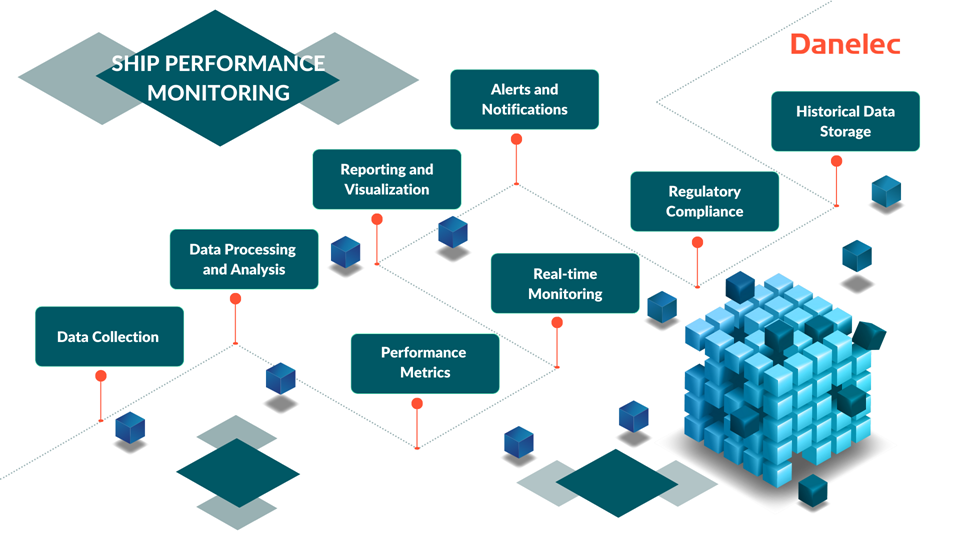
Understanding Ship Performance Monitoring
The term ‘ship performance monitoring’ covers a broad spectrum of technologies, applications and data, but a standard definition has yet to be adopted industry wide. This can lead to confusion for ship owners and managers seeking technology solutions that can help them optimise marine operations.
Part of the issue is that there is no standardisation within the realm of ship performance monitoring. It’s all proprietary, whether looking at technology, data formats, interfaces or capabilities. Therefore, most vessel or fleet installations are custom projects.
Which means when first approaching the procurement of a Ship Performance Monitoring system, it’s important to understand what you want to measure and how you want to measure it, as well as what you want to achieve with your data and how you achieve it.
The journey of data
One of the most effective ways to standardise and indeed simplify ship performance monitoring is to place the Voyage Data Recorder (VDR) at the centre of the infrastructure. The reason being that it is already on board and recording data, and in the case of Danelec VDRs already prepared to act as a secure manager of High Quality, High-Frequency (HQHF) data transfer to shore. When combined with data from a Shaft Power Meter to monitor torque, this establishes a solid baseline.
We can then follow the path that data should take via a ship performance monitoring system, until it transforms into value for its owner. In this context, the key features of a ship performance monitoring system typically cover eight key steps.
- Data Collection & Transfer: A wide range of data comes via the VDR and direct connection to various onboard sensors, equipment, and systems. The data is transferred to shore by satellite or 4G/5G if available, using the Danelec Vessel Remote Server as a central hub.
- Data Processing & Analysis: Data is processed and analyzed by the chosen apps to generate insights into the ship's operational performance. Advanced algorithms and analytics tools may be used to identify trends, anomalies, and areas for improvement.
- Performance Metrics: Fuel efficiency, energy consumption, emissions (such as CO2, SOx, NOx), speed optimization, and more can be calculated. These metrics help operators assess the ship's efficiency and environmental impact.
- Real-time Monitoring: Operators can make informed decisions and adjustments during the voyage to optimize fuel efficiency and other operational aspects with real time data and insight.
- Reporting & Visualization: Graphs, and visualizations can be generated to help operators understand the ship's performance over time. These insights can be used to identify potential areas for operational improvements.
- Alerts & Notifications: Operators and shore-based personnel can be notified automatically when performance parameters deviate from expected values or predefined thresholds.
- Regulatory Compliance: A ship performance monitoring system may also assist in complying with various international and regional regulations related to emissions, energy efficiency, safety and environmental protection.
- Historical Data Storage: Collected data is often stored for historical analysis, allowing operators to track performance trends, assess the impact of different operational strategies, and make data-driven decisions for future voyages.

A step towards standardization
Encompassing field-proven shaft power monitoring technology developed by Kyma, Danelec’s essential cloud technology, and apps from expert companies, the homogenous nature of DanelecConnect is a significant move towards ship performance monitoring standardization, as it is offered as a series of easy-to-deploy building blocks that cover every aspect of data acquisition, management and processing.
Agile cloud infrastructure means that practically any app can be deployed with DanelecConnect, allowing ship owners and operators to measure exactly what they want, in a way that suits the needs of their business. Data storage is safe and secure, ensuring integrity as it moves through the eight steps of ship performance monitoring.
Knowing the basic steps or capabilities unlocked by ship performance monitoring is just the start of a ship owner or operator’s journey to optimizing operations.
Get in-touch
To find out more about the topic and how a ship performance monitoring system could be shaped for your business and operational needs, contact us today.